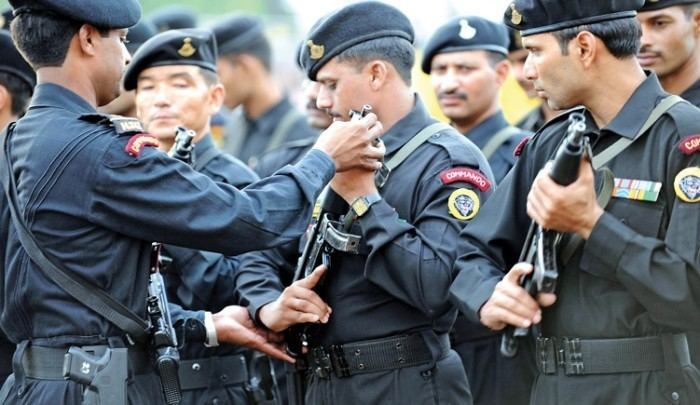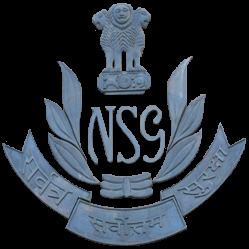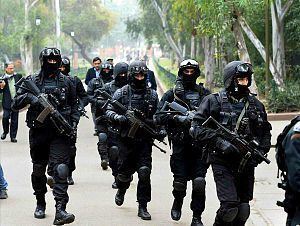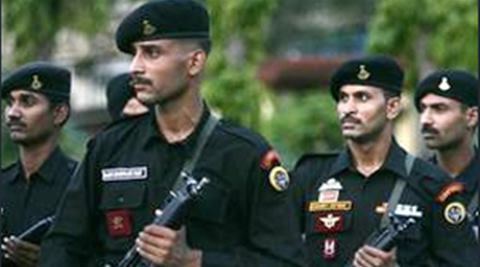Abbreviation NSG Founded 1984 Number of employees 7,500 | Formed 1984 | |
 | ||
Legal personality Governmental: Government agency Constituting instrument National Security Guard Act, 1986 General nature Law enforcementCivilian agency Annual budget 8.161 billion INR (2017–2018, US$121.3 million) Similar Indian Armed Forces, Indian Army, Indian Air Force, Paramilitary forces of India, Indian Coast Guard | ||
Indian special forces special action group national security guard nsg
The National Security Guard (NSG) is an Indian special forces unit under the Ministry of Home Affairs (MHA). It was raised in 1984, following Operation Blue Star and the assassination of Indira Gandhi, "for combating terrorist activities with a view to protect states against internal disturbances".
Contents
- Indian special forces special action group national security guard nsg
- India s national security guard nsg top 5 facts
- Mission
- Directors General
- Organization
- Headquarters
- Special Action Group SAG
- Special Ranger Group SRG
- National Bomb Data Centre
- Regional Deployment
- Rank Structure and Designation
- History
- Selection and training
- Equipment
- References
NSG is under the authority of Ministry of Home Affairs (India), However it is not categorised under the uniform nomenclature of Central Armed Police Forces. It has a special forces mandate, and its core operational capability is provided by the Special Action Group (SAG) which is drawn from the Indian Army. The Special Rangers Group (SRG), the police component of NSG, which also handles VIP security, is composed of personnel on deputation from other Central Armed Police Forces and State Police Forces.

The NSG personnel are often referred to in the media as Black Cats because of the black dress and black cat insignia worn on their uniform.

India s national security guard nsg top 5 facts
Mission

The National Security Guard (NSG) was set up in 1984 as a Federal Contingency Deployment Force to tackle all facets of terrorism in the country. As a specialized counter terrorism force, it is intended for use "only in exceptional situations" and not meant to take over the "functions of the State Police Forces or other Para Military Forces". Yet, over the years its role has vastly expanded to provide personal security to influential politicians quite independent of the real threat that they face.
The NSG is trained to conduct counter terrorist task to including counter hijacking tasks on land, sea, and air; Bomb disposal (search, detection and neutralization of IEDs); PBI (Post Blast Investigation) and Hostage Rescue missions.
Directors General
The head of NSG, designated as Director General (DG), is selected by the MHA-Home Minister. Since its raising in 1984, the NSG has had 28 DGs, in 31 years, with an average tenure one year and few months. Many have served as DG just for few months, while waiting for promotion or a more desirable post. None of the DGs has had experience of commanding NSG special actions groups, or any other special forces command experience . All the selected DGs have been officer from Indian Police Service (IPS). As per the government policy, NSG is to be headed by an Officer from IPS. Since the Combat Units under the NSG, which conduct counter terror operations are commanded by the Army Officers, this effectively negates the possibility of any officer with field experience in counter terror operations heading the organisation as its DG at a later stage.
Organization
According to the NSG web site it is modeled on Germany's GSG 9 (Grenzschutzgruppe 9 or "Border Guard Group 9").
Headquarters
At Mehram Nagar, Palam
Administration The Director General is assisted by four Indian Police Service officers for administrative matters of whom two are Inspectors General each for Administration and Headquarters (HQ) who in turn are assisted by Deputy Inspectors General. The Financial Advisor of the NSG has been an Indian Revenue Service (IRS) officer of the rank of Joint Secretary and also has Dy Advisors from the Indian Audit and Accounts Service and Indian Civil Account Service.
Operation and Training: Operations and training is under senior army officers on deputation to NSG. A Major General of Indian Army, on deputation, designated as Inspector General (operations), is responsible for planning and conduct of operations. Training is under another Major General (Training), located in Manesar, Gurgaon. They are further assisted by two Brigadiers on deputation from Indian army as DIG (Operations) and DIG (Training). Another Brigadier from army usually from Indian Army Corps of Signals is deputed as DIG (Communication) to look after communication systems of the force. The strength of the NSG is estimated to be about 8000+ personnel. Air transport to support NSG is located at Indira Gandhi Airport.
National Bomb Data Centre: NBDC a nodal agency covering all facets of Bombing incidents in India. It is headed by a Colonel of Indian Army Corps of Engineers on deputation, designated as Director NBDC.
Special Action Group (SAG)
The SAG is the main offensive or the strike wing of the NSG. Its members are drawn exclusively from the Indian army. The SAGs includes headquarters, support units, and training wing. The training of both the action and ranger group is conducted by the officers and NCOs drawn from the army. There are two SAGs – 51 Special Action Group and 52 Special Action Group. The two SAGs (51 and 52) are tasked for counter-terror and counter-hijack operations respectively. The smallest operation sub unit of the SAG is called "hit", usually commanded by an NCO. A "hit" has five members – two pairs, or buddies, and a technical support member. Four hits make a team. A team is commanded by a Captain. In hostage rescue operations, depending on the situation, team size may vary between 50 to 90 NSG personnel. For immediate transport airlift IL-76MD strategic transport aircraft are stationed at New Delhi’s Palam Air Force Station and are ready to deploy within 30 minutes.
Special Ranger Group (SRG)
NSG has three SRGs, each with a strength of battalion, approximately total 900 all ranks. SRG personnel are drawn on deputation from Central Armed Police Forces and State Police forces. There are three SRGs – 11, 12 and 13. Initially SRG's mandate was to render logistical support to the SAGs during operations and are deployed for guarding high-risk VIPs/VVIPs. However, Since 2013, 11SRG is converted into a regular SAG unit for undertaking specific counter-terror operations.
National Bomb Data Centre
The National Bomb Data Centre (NBDC) established in the year 1988 & further its role redefined in the year 2000. NBDC was assigned role of monitoring, recording and analysing all bombing incidents in the country. It also records and analyses various bombing incidents across the world to gain expertise knowledge in Bombing and related incidents and effectively counter such and share with relevant security agencies. All national security agencies which rely on NBDC for assistance in bombing incidents and related knowledge have high regards for its working culture. At present NBDC act as a nodal agency for all bombing related facets in the country.
It is headed by a Colonel of Indian Army Corps of Engineers on deputation, designated as Director NBDC.
National Bomb Data Centre primarily consists of personnel and officers from Indian Army Corps of Engineers who are Combat Engineers along with personnel and officers from Central Armed Police Forces with bombing related expertise knowledge.
Regional Deployment
In response to criticism of the time taken by NSG units to arrive in November 2008 Mumbai attacks, from their base in Manesar, Haryana, the MHA decided to deploy NSG contingents in major cities across India like Mumbai, Kolkata (462 personnel), Hyderabad and Chennai.
Hyderabad will turn into a training hub of the elite 'Black Cats' by mid-2014. With the ministry of home affairs (MHA) giving its nod and sanctioning Rs 533.68 crore a few months ago, the National Security Guard (NSG) officials are gearing up to set up the Southern Regional Center (SRC) at Ibrahimpatnam, Hyderabad for training commandos. With the state government also handing over 600 acres at Ibrahimpatnam, the SRC is likely to be ready by next year. Tender notices have already been issued for civil works, which would be overseen by the Central Public Works Department. With this, Hyderabad would have an NSG hub at Trimulgherry as well as the SRC for training 'Black Cats'. As of now, nearly 300 commandos, ready for anti-terror operations round-the-clock, are stationed at the NSG hub at Trimulgherry. Similar hubs are in place in Mumbai, Chennai and Kolkata. The proposal to set up a state-of-the-art NSG training centre at Ibrahimpatnam on the lines of NSG Manesar training centre has been pending for over three years. But the MHA officials, in their annual report released recently, announced the release of funds for developing infrastructure. "Post the 26/11 Mumbai terror strike, four regional hubs of NSG were operationalised in Mumbai, Hyderabad, Chennai and Kolkata to reduce reaction time. A regional centre at Hyderabad is also being raised, for which 600 acres of land has been acquired. MHA has conveyed sanction of Rs 533.68 crore towards the construction of this Southern Regional Centre, NSG at Ibrahimpatnam," the MHA report said. With this, the state would have two trained anti-terror striking forces. Besides the NSG, the Andhra Pradesh police's OCTOPUS, which also has a training facility at Ibrahimpatnam, has a strength of over 250 personnel. NSG and OCTOPUS personnel, who undergo a gruelling training, including handling sophisticated weapons, commandos are sent back to their parent department once they attain the age of 35, ensuring that the force remains young and fighting fit.
Rank Structure and Designation
The ranks in NSG are roughly on the pattern of the police and the CAPF, as follows:
History
The NSG was established in the wake of 1984 Operation Blue Star, and the high collateral damage to Golden Temple, and civilian and military collateral casualties. Since its raising the NSG has been used in the Punjab in 1986, and Jammu and Kashmir. Some of the NSG's known operations include:
Selection and training
Selection is demanding and has a drop out rate of about 70–80 percent. Three of their 14 months of training in Manesar, Haryana, are devoted to the basics.The basic training period lasts 90 days. Physical fitness training has 26 elements, ranging from a cross-country obstacle course to jumping from heights and across divides and scaling different kinds terrain. One endurance test involves martial arts, target shooting at the end of an obstacle-ridden cross-country run. This is meant to gauge the candidate’s performance under conditions of stress and exhaustion. Those who successfully complete the tests are sent for nine months of advanced training.
